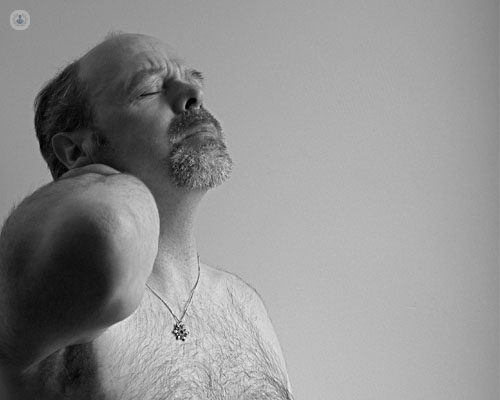

What is it?
Torticollis can be described as a prolonged neck muscle contraction. It can cause pain as well as rotating and tilting of the head.
There is muscular pain in the neck area which can travel up to the head or go down to the shoulder or back.

Condition prognosis
It is easy to treat in babies and children. If it becomes chronic, numbness and tingling may be experienced due to the pressure on the nerve roots in the neck.
What are the symptoms?
Symptoms are easy to identify and include:
- limited neck movement
- headache
- cervical pain
- shaking of the head
- sternocleidomastoid muscle stiffness
- abnormal head posture
- having one shoulder higher than the other.
Tests for torticollis
Diagnosis involves a physical exam to check for:
- wrong head position. In more serious cases, the head may be displaced and bent to one side.
- stiffness and shortening or lengthening of neck muscles.
Tests may include:
- neck X-ray
- neck CT scan
- electromyography (EMG) to check the affected muscles
- brain MRI
- blood tests to check for related diseases.
What causes it?
The main causes of torticollis are:
- genetic factors
- problems with the nervous system, upper part of the spine, or muscles
- bad posture or a sudden movement that causes muscle injury
- fatigue and stress may also be a contributing factor.
In cases of torticollis from birth, it may be due to bad uterine head positioning or if the neck muscles and blood supply were affected.
How can it be prevented?
There is no known way to prevent it but it is recommended to avoid bad posture, especially when sleeping or carrying out daily tasks.
Relaxation techniques and cervical stretching can help reduce the chances of developing torticollis. Early detection can avoid making it worse.
What is the treatment?
Treatment depends on the cause, whether it’s from nervous system, spine, or neck muscle damage. Depending on the cause, the following treatments may be recommended:
- applying heat, massage, or cervical traction. This can relieve head and neck pain.
- stretching exercises.
- injecting botulinum or other pain relievers in the affected area.
- using a neck brace.
- spinal surgery is carried out if the torticollis is due to dislocated vertebrae.
In cases of torticollis from birth, neck muscles should be stretched alongside exercises such as passive positioning. If these treatments are not enough, then surgery may be considered.
What specialist should I see?
Torticollis is treated by an orthopaedic surgeon or a physiotherapist.
